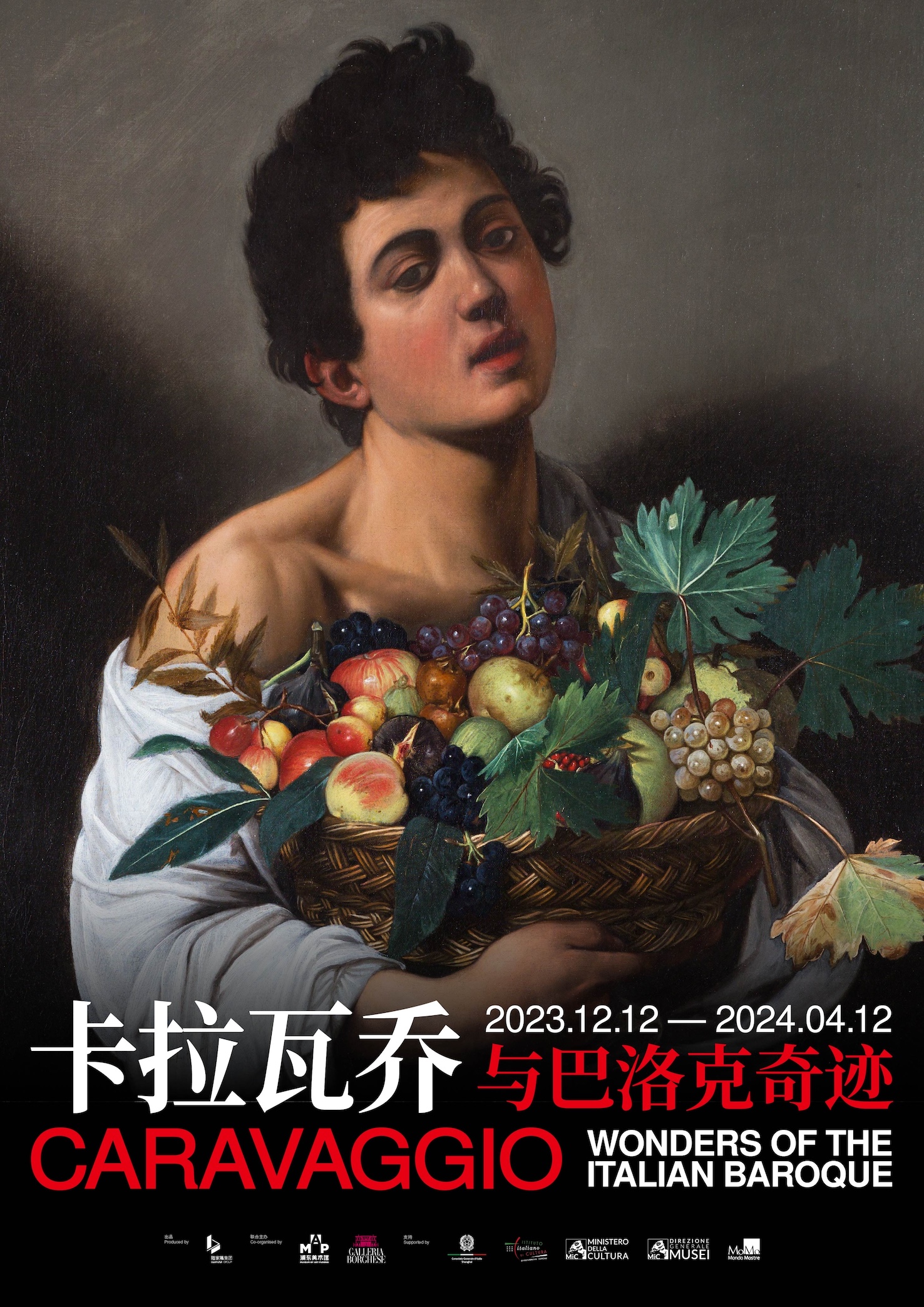
 Press Center
Press Center
Caravaggio. Wonders of the Italian Baroque, the final exhibition of the year at Museum of Art Pudong, will open to public on December 12, 2023. Being the first Caravaggio-themed exhibition in China, the exhibition marks the first collaboration between MAP and Galleria Borghese in Rome, which boasts the largest gathering of Caravaggio's works in a single collection. With over 60 authentic works on view, among which 6 are iconic masterpieces by Caravaggio and others by over 40 Baroque artists, the exhibition presents a fantastically holistic picture of Baroque art. In the meantime, Baroque architectural and music elements integrated into the scenography collectively enhance the theatrical viewing experience, allowing visitors to immerse fully in the epoch-making and revolutionary aesthetics unique to Baroque.
Caravaggio. Wonders of the Italian Baroque is produced by Shanghai Lujiazui Development (Group) Company Limited and co-organized by Museum of Art Pudong and Galleria Borghese in Rome with the collaboration of Gallerie degli Uffizi, Florence, Gallerie Nazionali di Arte Antica (Barberini-Corsini), Rome, Banca Popolare di Vicenza S.p.A. in LCA and private collector in Florence. A total of five organizations have joined forces to bring together six authentic Caravaggio paintings to MAP, making this unprecedented "Wonders of the Italian Baroque" a reality.
The exhibition receives support and promotion by Consulate General of Italy in Shanghai, Italian Cultural Institute in Shanghai, Ministero della Cultura Italy, Direzione Generale Musei, Ministero della Cultura Italy and MondoMostre Rome. Francesca Cappelletti, Director of Galleria Borghese Museum, and Francesco D'Arelli, Director of Italian Cultural Institute in Shanghai, take the role as curators of the exhibition; Aldo Cibic, renowned Italian designer, co-founder of the Memphis group and Honorary Professor at Tongji University, design the scenography together with Joseph Dejardin.
A Brilliant Representation of the Wonders of Baroque Art
All the way from Rome to Shanghai
Michelangelo Merisi, called Caravaggio was one of the most revolutionary painters in the history of Western art. He is widely considered the last master from the Renaissance period and the pioneer to trigger the beginning of Baroque period. The absolute novelties introduced by Caravaggio in painting were the study of truth against all academic rules, and the stark use of light as a metaphor for divine grace. With the brand-new style in painting, Caravaggio managed to create a new wave in European arts after the Renaissance, exerting profound influence upon many artists of and after his time – among whom Rubens, Rembrandt and La Tour were all his followers.
Nowadays Caravaggio's works are in permanent collections of prestigious art institutes all around the world, including the Musée du Louvre, the Metropolitan Museum of Art, the Hermitage Museum and the National Gallery London. Caravaggio was only 38 when he died, and left behind only a handful of works that can be definitely attributed to him, which means works available for loan are extremely rare. In this exhibition, Boy with Basket of Fruit, one of Italy's most precious art treasures from the collection of Galleria Borghese, will make its debut in museum-level exhibition in China. On December 8, MAP organized a special crate-opening ceremony to celebrate the arrival of this brilliant masterpiece.
Boy with Basket of Fruit is one of Caravaggio's earlier works. The artwork shows a young man, in a three-quarter pose, holding a basket full of autumn leaves and fruits, such as apples and bunches of grapes. In this work, light certainly has the leading role, seeping in from behind the boy and reflecting off the basket, revealing its contents with all their irregularities and imperfections. This painting constitutes admirable evidence of the representation of the real; indeed, with this canvas, the artist displays his ability to investigate the natural world with profound capacity of mimesis, devoid of aestheticizing interpretations.
Baroque is a style that developed in the 17th century, an era of astronomical discoveries, absolute rulers, and the Counter-Reformation. The term "baroque" derives from the Portuguese word barroco and the Spanish word barrueco, indicating an irregular pearl, not perfectly round, which in Italian is called scaramazza, or river pearl. As an all-embracing style, Baroque first appeared in the field of architecture – architects began to go beyond the fixed patterns of classical order, imbuing architecture with a strong sense of ornamentation and exuberance.
At the time, Rome was the irradiating hub, the pivotal point of this artistic tide: a place that we can imagine being an enormous construction site attracting architects and artists from all over Italy. Artists, architects, decorators and craftsmen from around Europe also flocked to the city to learn this innovative style. The city became the ideal support for spectacular images of triumph, where one was dazzled by the admirable fusion of different techniques such as painting, sculpture, and architecture to form a unique and astounding work of art.
Gian Lorenzo Bernini (Naples 1598 - Rome 1680) was a master of fusing different techniques of painting, sculpture and architecture. He was a great architect: from a young age he worked on the most important and representative monument of Baroque, the Roman basilica of St. Peter's. He was also a great painter. In portraiture, he was able to renew and change tradition. On display here in Shanghai includes his Self-Portrait at a Mature Age, which is the culminating work of the representations Bernini produced of himself. It enjoys extraordinary notoriety, also aided by the enormous diffusion resulting from its transposition onto Italian 50,000 lire banknotes for many years.
"The exhibition is a celebration of Baroque pictorial art in all its forms. It showcases a perpetual dialogue between the past and the present, and between the different artistic personalities that characterized that era. The aim is to express the artistic trepidation that was prevalent during that period, full of continuous inspiration, against a backdrop of great change in history." said Francesco D'Arelli, co-curator of the exhibition and Director of Italian Cultural Institute in Shanghai. According to Francesca Cappelletti, co-curator and Director of Galleria Borghese Museum, "We're very glad to present this exhibition at the Museum of Art Pudong and very grateful to MAP for this great opportunity to introduce the art from Italy to Chinese audience through the presentation of the collection of Galleria Borghese."
Scenography with a Touch of Music
A Truly Immersive Baroque Experience
The Baroque era in music is usually slated between the beginning of the 17th century and the middle of the 18th century, approximately the end of the Renaissance. Baroque music was known for its grandiose spirit and stylistic diversity. Caravaggio. Wonders of the Italian Baroque also pays homage to the musical arts. Baroque music here delights visitors throughout the exhibition and reminds people that it was used at that time to celebrate the secular powers with courtly and majestic tones. This musical trend paved the path towards the celebrated tradition of melodrama and opera.
The scenography of the exhibition takes into consideration concepts of light and shadow, colors and spatial layout that are unique to Baroque style. The use of light pays homage to Caravaggio, the master of light who adopted chiaroscuro as a prominent aesthetic characteristic, intensifying the shadows and deploying clearly outlined beams of light for emphasis and to enhance the storyline of the painting. Like a movie director, he guided audiences' view through light to the climax of the stories in the paintings, where the characters stood out so starkly against the dimly lit backdrop. The uniquely choreographed effect of light and shadow enables viewers on the outside of painting to empathize with the profound emotions exuberated from the characters inside. One central premise of the exhibition is that as the viewers progress through the exhibition, the lighting levels reduce, until the final room displays Caravaggio's work. The lighting levels there are very low, heightening the drama of the chiaroscuro. Such a design is inspired by the fact that these works would originally have been experienced by candlelight.
As exhibition designer Aldo Cibic put it: "The layout of the exhibition references a few ideas relating to the baroque: firstly, the nave-type corridor axis moving between chapel-like space; and secondly the idea of enfilade building up a layering of spaces and focusing the view of the visitors. Perhaps the most immediately obvious aspect of Baroque architecture is the conspicuous use of ornament. Throughout the exhibition we reference this through citations of architectural elements, subtly embellishing the space." One of the main characteristics of Baroque was illusionism. At the time artists often resorted to the rules of perspective to amaze viewers with what we would call today special effects. The curation and design of the exhibition, to an extent, also create certain "illusion", inviting people to embark on the marvelous journey to the Baroque era full of wonders, and to explore, contemplate and revisit the power of art to communicate beyond boundaries.
【Exhibition Poster】
About Museum of Art Pudong
Located at the heart of Xiao Lujiazui, the Museum of Art Pudong (MAP) broke ground on September 26, 2017 and opened to the public in July, 2021.
Invested, built, and managed by the Lujiazui Group and designed by Ateliers Jean Nouvel (AJN), MAP is primarily set out to present world-class exhibitions to its audience as well as showcasing domestic artists. The four major functions of MAP include: to hold exhibitions, to promote art education, to develop cultural merchandises, and to advocate for international exchange. MAP aims to become a new cultural landmark of Shanghai and an important platform for international cultural exchange.

 PREV
PREV

 沪公网安备 31011502017932号
沪公网安备 31011502017932号



